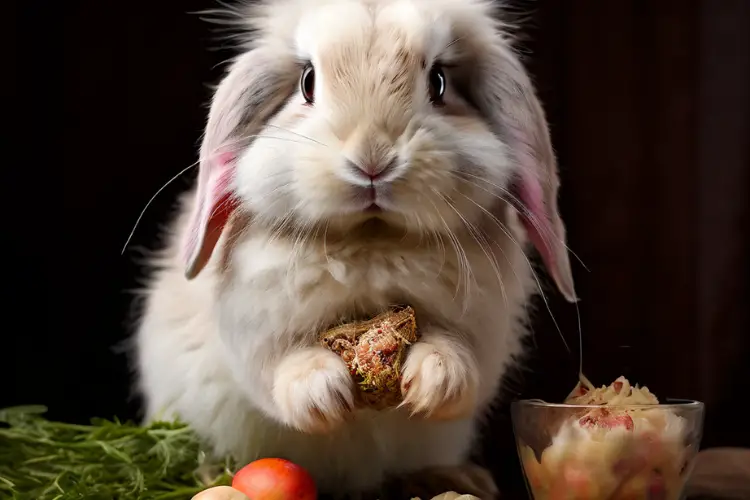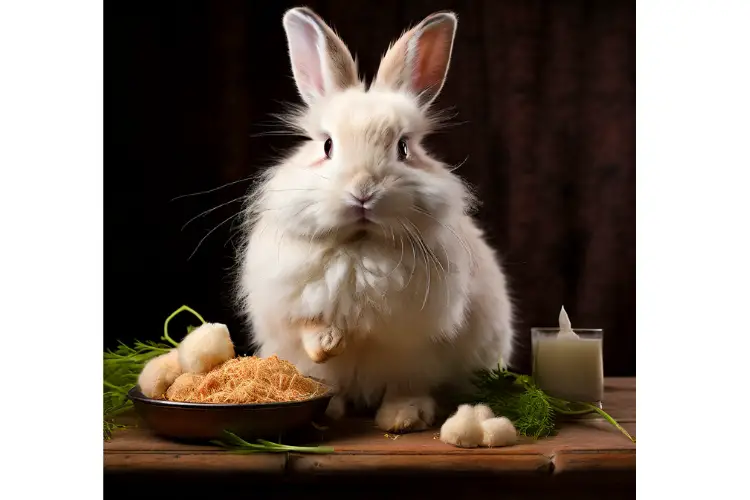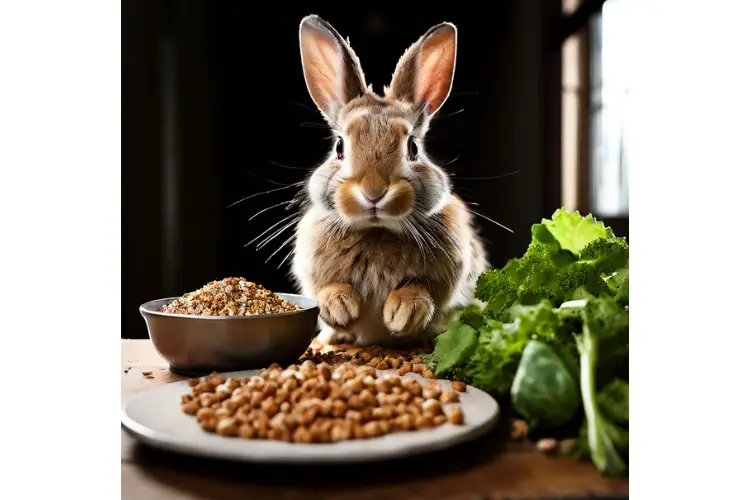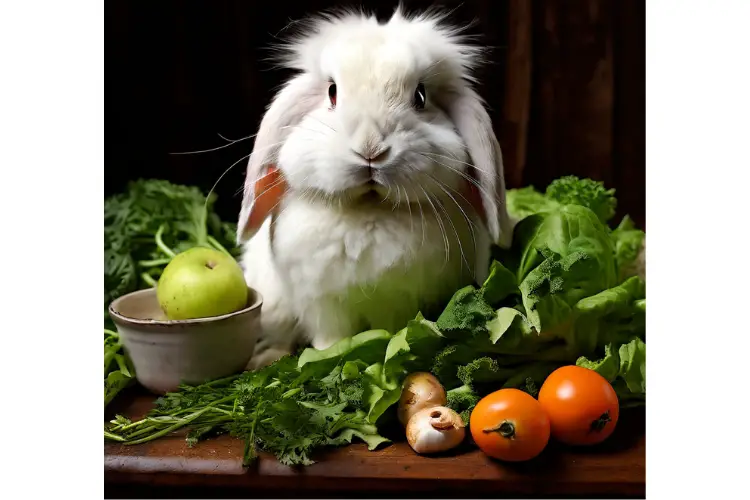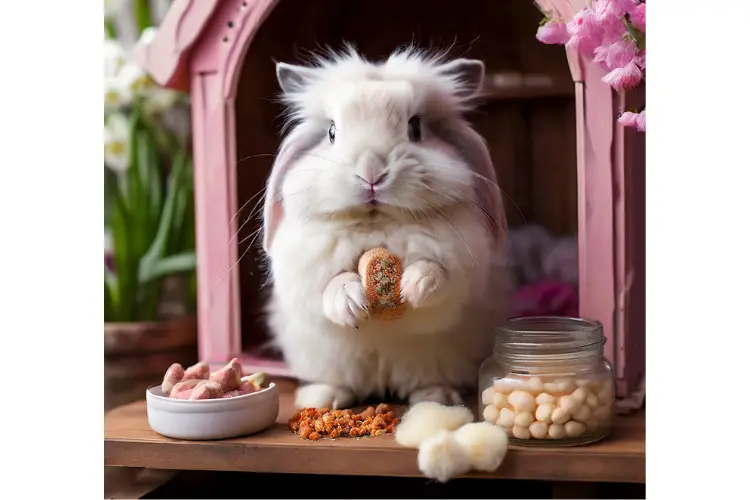The Angora rabbit, renowned for its luxurious fur, demands a specialized diet to maintain its health and vigor. Understanding the dietary needs of these herbivorous pets is crucial for their well-being.
In this blog post guide, we will explore about the essentials of an Angora rabbit’s diet, the importance of portion control, the incorporation of fresh foods, and the role of treats and supplements, providing a comprehensive feeding guide for these delicate creatures.
Key Takeaways
- Angora rabbits require a diet high in fiber with unlimited hay to support their digestive health and manage their continuously growing teeth.
- Commercial rabbit food should be given in controlled portions to prevent obesity, with specific recommendations varying based on the rabbit’s weight.
- Fresh foods and greens should be introduced gradually to a mature rabbit’s diet, with attention to quantity and variety to avoid digestive issues.
- Seeds and nuts can serve as occasional treats, offering benefits for giant breeds and senior rabbits, but should be given in moderation to prevent GI obstruction.
- A constant supply of water is essential, and while pellets have nutritional value, they should complement a hay-based diet to ensure proper hydration.
Understanding the Basics of an Angora Rabbit’s Diet
The Importance of Hay in Daily Nutrition
Ensuring that your Angora rabbit has a constant supply of hay is crucial for their well-being. Hay is not just a filler; it’s the cornerstone of their diet, providing both the necessary fiber and protein that these animals require for a healthy digestive system and overall health.
Hay should constitute at least 75% of an Angora rabbit’s diet, and it’s important to provide an unlimited supply to prevent digestive issues and to maintain proper dental health. The fiber content in hay is essential for wearing down their continuously growing teeth and for keeping their GI tract moving.
Hay varieties such as Timothy, Orchard, and Meadow are excellent choices for your rabbit. Each type offers a slightly different nutritional profile, so providing a mix can be beneficial.
While hay is the main component, it’s also important to balance their diet with other nutrients. Here’s a simple breakdown of the macronutrient requirements for a healthy rabbit diet:
- Fiber: Up to 20%
- Carbohydrates: Around 45%
- Protein: Adequate levels for growth and maintenance
Remember, a well-balanced diet is the key to a healthy, happy Angora rabbit.
Balancing Macronutrients: Fiber, Carbohydrates, and Proteins
Angora rabbits, like all rabbits, have specific dietary needs that must be met for optimal health. Ensuring a balanced intake of fiber, carbohydrates, and proteins is crucial for maintaining their delicate digestive systems and supporting their wool production. A constant supply of hay is essential, as it provides both the necessary fiber and protein.
Rabbits require a diet composed of up to 20% fiber and 45% carbohydrates. While hay meets a significant portion of these needs, pelleted commercial feeds can offer a complete nutritional profile at the time of manufacture. However, it’s important to note that certain vitamins in these pellets, such as A and E, can degrade over time, especially with poor storage.
To supplement these vitamins naturally, consider adding a tablespoon of black oil sunflower seeds for Vitamin E and a handful of dark leafy greens for Vitamin A to your rabbit’s diet. These should be given in moderation alongside vegetables to provide additional nutrients without overloading their system.
It’s essential to monitor the amount of seeds, nuts, and other high-fat treats given to rabbits. While an occasional teaspoon can be beneficial, excessive amounts, often found in muesli mixes, can lead to imbalances and health issues.
The Role of Water in Rabbit Hydration and Health
Ensuring that your Angora rabbit has access to fresh water at all times is crucial for their health. Water is essential for maintaining a healthy digestive system, particularly due to the high fiber content in their diet.
Without sufficient water intake, rabbits can suffer from dehydration, leading to serious health issues such as constipation or gastrointestinal blockages.
Rabbits’ teeth are ever-growing, and while a diet rich in hay helps to keep their teeth in check, it is the water content in fresh foods that aids in overall hydration. Pellets, although nutritious, lack the water content found in fresh foods and hay, making it all the more important to provide a constant supply of water.
Ample water intake is not just a necessity, it’s a preventative measure to ensure the well-being of your Angora rabbit. It supports the digestion of fiber and reduces the risk of dental and digestive problems.
Remember, a rabbit’s diet should consist of up to 20% fiber and 45% carbohydrates, and water plays a pivotal role in the digestion of these nutrients. Always monitor your rabbit’s water bowl or bottle to keep it clean and full, as a hydrated bunny is a happy and healthy bunny.
Commercial Rabbit Food and Portion Control
Daily Serving Recommendations
When it comes to feeding your Angora rabbit, understanding the appropriate serving sizes is crucial for maintaining their health. Rabbits require a balanced diet that includes a mix of hay, fresh vegetables, and a controlled amount of pellets. Overfeeding, especially with pellets, can lead to obesity and other health issues.
It’s essential to tailor the portion sizes to the specific needs of your rabbit, taking into account their weight and activity level.
Here is a simple feeding chart to help guide you:
| Weight of Rabbit | Leafy Greens | Pellets |
|---|---|---|
| 2 lbs | 1 cup | 2 tbsp |
| 3 lbs | 1.5 cups | 3 tbsp |
| 4 lbs | 2 cups |
Remember, this chart is a starting point, and you may need to adjust portions based on your rabbit’s individual needs. Always monitor your rabbit’s weight and consult with a veterinarian if you’re unsure about the correct serving sizes.
Risks of Overfeeding and Obesity
Overfeeding Angora rabbits can lead to a host of health issues, including obesity, which is a significant concern for these pets. Obesity in rabbits can reduce their lifespan and lead to serious health complications. It’s crucial to monitor their diet closely and ensure they are not consuming more calories than they require for their activity level and size.
Overweight rabbits may not show any interest in mating and can have a hard time becoming pregnant if mating does occur.
Feeding an appropriate amount of pellets is essential, as overfeeding can cause soft stools and increase the risk of obesity. Treats should be given sparingly, as rabbits can easily develop a preference for these over their regular, nutritious food. Avoid treats with high sugar content, such as yogurt drops and honey sticks, which can wreak havoc on their digestive system and contribute to weight gain.
Here is a list of treats to avoid to prevent obesity in Angora rabbits:
- Chocolate
- Cookies
- Crackers
- Bread
- Cake
- Muffins
- Chips
- Popcorn
- Yogurt
- Honey
- Pasta
- Candy
- Any other processed foods
Transitioning to Pellets: A Guide for Young Rabbits
When young rabbits reach the age of about 6 months, their diet can start to include pellets as a supplement to hay. Introduce pellets gradually to avoid upsetting their sensitive digestive systems. Begin with small amounts and observe your rabbit’s response before increasing the portion.
Pellets should complement, not replace, the essential hay in a rabbit’s diet. They provide concentrated nutrients but lack the fiber necessary for optimal dental and digestive health.
Here’s a simple feeding chart for transitioning to pellets:
| Weight of Rabbit | Leafy Greens per Day | Pellets per Day |
|---|---|---|
| 2 lbs | 1 cup | 2 tbsp |
| 3 lbs | 1.5 cups | 3 tbsp |
| 4 lbs | 2 cups | \ rac{1}{4} cup |
| 5 lbs | 2.5 cups | 1 tbsp + \ rac{1}{4} cup |
Remember to provide fresh water at all times, as pellets do not contain the moisture found in fresh foods. Monitor your rabbit’s weight and adjust the diet as necessary to maintain a healthy balance.
Incorporating Fresh Foods and Greens
Safe Leafy Greens and Serving Sizes
When incorporating fresh greens into your Angora rabbit’s diet, it’s crucial to understand the appropriate serving sizes to maintain their health. Leafy greens should be a staple in their daily intake, providing essential nutrients and fiber. A variety of greens can be offered, but it’s important to introduce them gradually to prevent digestive upset.
Here is a simple guide for serving sizes based on the rabbit’s weight:
| Weight of Rabbit | Total Amount of Leafy Greens per Day |
|---|---|
| 2 lbs | 1 cup |
| 3 lbs | 1.5 cups |
| 4 lbs | 2 cups |
| 5 lbs | 2.5 cups |
| 6 lbs | 3 cups |
| 7 lbs | 3.5 cups |
| 8 lbs | 4 cups |
| 9 lbs | 4.5 cups |
| 10 lbs | 5 cups |
Remember, while leafy greens are important, they should be part of a balanced diet that includes hay, pellets, and fresh water.
Healthy vegetables such as broccoli, celery, carrot tops, bok choy, and dark leafed lettuce varieties are excellent choices. Herbs like parsley, oregano, and coriander can also be included to add variety and additional nutrition. Always wash the greens thoroughly before serving to remove any pesticides or contaminants.
Introducing New Foods to Your Rabbit’s Diet
When expanding your Angora rabbit’s diet beyond hay and pellets, it’s crucial to introduce new foods gradually. Start with small amounts of one new food at a time to monitor your rabbit’s reaction and ensure it doesn’t cause gastrointestinal distress, which can be serious for their health.
Introducing a variety of foods not only provides additional nutrition but also enriches your rabbit’s life with different tastes and textures.
Here’s a list of safe foods to introduce to your rabbit’s diet:
- Romaine lettuce
- Celery
- Cabbage
- Cauliflower
- Alfalfa hay
For occasional treats, due to their higher sugar content, consider:
- Peaches
- Melons
- Peppers
- Carrots
- Blueberries
Remember to introduce these treats sparingly to avoid upsetting your rabbit’s sensitive digestive system. Close monitoring after introducing new foods is imperative to catch any signs of GI distress early.
Understanding the Sensitive Rabbit Digestive System
Angora rabbits, like all their kin, have a delicate digestive system that requires a careful approach to diet changes. Introducing new foods should be done gradually to avoid upsetting their stomachs. Start with small amounts of a single new food and monitor your rabbit for any signs of distress or digestive issues.
It’s crucial to understand that rabbits cannot vomit, so any problematic foods can cause severe GI obstruction or stasis, which is life-threatening.
When incorporating fresh foods into your rabbit’s diet, consider the following guidelines:
- Introduce one new food at a time.
- Begin with a small portion and gradually increase it over a week.
- Observe your rabbit closely for any adverse reactions.
- If any digestive upset occurs, remove the new food immediately.
Remember, a rabbit’s diet should be primarily hay-based, complemented by a balanced mix of nutrients. Avoid treats with high sugar content and be wary of pet store offerings that may not be suitable for your rabbit’s health.
Treats and Supplements for Angora Rabbits
Seeds and Nuts: Occasional Treats with Benefits
While seeds and nuts are not a staple in the diet of an Angora rabbit, they can serve as beneficial treats in moderation. These treats offer valuable fats and proteins that can be particularly helpful for certain rabbits, such as giant breeds, long-haired varieties like Angoras, and senior rabbits that may require additional calories to maintain a healthy weight.
It’s crucial to avoid small seeds that can lead to gastrointestinal obstructions and to ensure that all nuts and seeds given are unsalted and raw.
Rabbits can safely enjoy approximately 1 teaspoon of the following seeds and nuts:
- Almonds
- Sunflower Seeds
- Pumpkin Seeds
- Walnuts
However, it’s important to distinguish between these occasional treats and commercial muesli mixes. The latter often contains a mix of seeds, nuts, and dried fruits, which can lead to overconsumption and nutritional imbalances. An occasional teaspoon of seeds or nuts is significantly less than what is typically found in these mixes, and therefore, is a safer option for treating your rabbit.
Identifying Safe Treats and Avoiding GI Obstruction
When considering treats for your Angora rabbit, it’s crucial to identify safe options and avoid those that can cause gastrointestinal (GI) obstruction. Treats should be given sparingly and should never include processed foods such as chocolate, cookies, or candy. These can lead to obesity and digestive issues.
Safe treats include small pieces of fruit like peaches, melons, and blueberries. However, always introduce new treats gradually and monitor your rabbit’s reaction closely, as GI distress can be serious and lead to dehydration.
It’s essential to be mindful of the treats available at pet stores. Many contain ingredients that rabbits cannot digest properly, such as yogurt drops and honey sticks, which are high in sugar.
For those looking for natural treat options, consider supporting small businesses that specialize in organic products for small animals. These treats are often healthier and tailored to meet the dietary needs of rabbits.
Supplementing Diets for Special Needs: Giant Breeds and Senior Rabbits
When caring for giant breeds or senior rabbits, their dietary needs can differ significantly from those of younger or smaller rabbits. Giant breeds, such as Flemish Giants, may require additional calories to maintain their larger body size, while senior rabbits often need support for joint health and digestion.
For senior rabbits, products like ‘Old Timer‘ from NHV Natural Pet Products can offer comprehensive support, ensuring they age gracefully with a diet tailored to their changing needs. These supplements are all-natural and vet-approved, focusing on plant-based ingredients.
It’s crucial to monitor the weight and overall health of your rabbit regularly, adjusting their diet as necessary to prevent obesity or malnutrition.
Incorporating safe treats, such as unsalted and raw almonds or pumpkin seeds, can provide valuable fats and proteins. However, these should be given sparingly to avoid gastrointestinal issues. Below is a recommended treat portion for senior and giant breed rabbits:
- Almonds: 1 teaspoon
- Sunflower Seeds: 1 teaspoon
- Pumpkin Seeds: 1 teaspoon
- Walnuts: 1 teaspoon
Conclusion
In summary, the diet of an Angora rabbit should be carefully managed to ensure their health and well-being. Unlimited hay is the cornerstone of their diet, providing essential fiber and aiding in dental health. Pellets should be given in moderation, as they are nutrient-rich but calorie-dense.
Treats like seeds and nuts can be offered sparingly, especially to long-haired breeds like Angoras that may require extra calories. Always introduce new foods gradually to avoid digestive upset. Remember, a well-balanced diet not only maintains your rabbit’s physical health but also contributes to their overall happiness.
FAQs:
How often should I feed my Angora rabbit?
You can provide an unlimited amount of hay to your Angora rabbit as it’s essential for their digestion and dental health. Limit commercial rabbit food to small daily portions to prevent obesity.
Are seeds and nuts safe treats for my Angora rabbit?
In moderation, seeds and nuts can be beneficial, especially for giant breeds or senior rabbits needing extra calories. Offer them sparingly, about 1 teaspoon, ensuring they are unsalted and raw. Avoid small seeds to prevent GI obstruction.
What is a healthy portion size of pellets for my Angora rabbit?
The portion size of pellets depends on your rabbit’s weight. For example, a 4 lb rabbit should get 1/4 cup of pellets per day. Adjust portions accordingly to maintain a healthy weight.
Can I feed my Angora rabbit fresh greens?
Yes, but introduce fresh greens gradually once your rabbit is about 6 months old. Start with small amounts and one type of green at a time to ensure it agrees with their sensitive digestive system.
What should the macronutrient balance be in my Angora rabbit’s diet?
Rabbits require a diet high in fiber (up to 20%) and carbohydrates (around 45%), with an adequate amount of protein. Hay provides an excellent base for these needs.
Is it necessary to provide water if my rabbit eats fresh foods?
Yes, it’s essential to always provide fresh water to your rabbit. While fresh foods contain water, rabbits still need a constant water supply for hydration and overall health.

